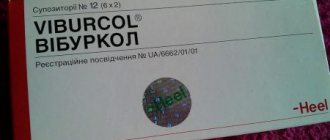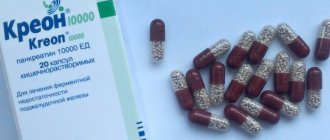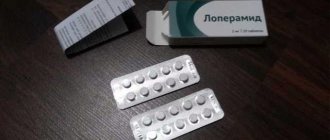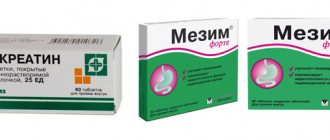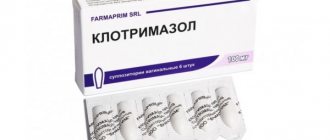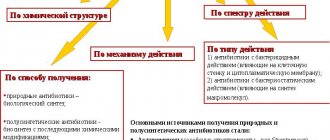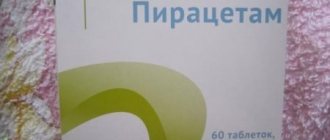Heparin ointment during pregnancy is a product that is not recommended for use during pregnancy or breastfeeding.
But a doctor can prescribe it if the therapeutic effect outweighs the risk of side effects. Therapy is carried out with caution, taking tests. Heparin ointment - analogues, substitutes
Heparin ointment for bruises on the face
Heparin ointment for breastfeeding
Heparin ointment for bags under the eyes
Find the answer
Are you having any problem? Enter “Symptom” or “Name of the disease” into the form, press Enter and you will find out all the treatment for this problem or disease.
The site provides reference information. Adequate diagnosis and treatment of the disease is possible under the supervision of a conscientious doctor. Any medications have contraindications. Consultation with a specialist is required, as well as detailed study of the instructions! Here you can make an appointment with a doctor.
Heparin ointment during pregnancy - can it be used and how?
The drug consists of 3 active components:
- sodium heparin – eliminates inflammation, swelling, thins the blood;
- benzocaine – pain reliever;
- benzyl nicotinate - delivers the active substance into the systemic circulation through the skin surfaces.
Indications for use:
- inflammation of the veins with the appearance of blood clots (thrombophlebitis);
- swelling of the limbs and other parts of the body;
- hematomas due to injuries and bruises;
- haemorrhoids.
Due to the compression of the vessels of the circulatory and lymphatic system by the fetus, pregnant women develop swelling and hemorrhoids in the rectum. The limbs increase in size, movements become difficult, reducing the standard of living. When the veins expand, bruises and hemorrhages appear.
Gynecologists recommend using heparin-based liniment only in the absence of contraindications or pathology of the coagulation system, starting from the 2nd trimester. It is applied no more than 2 times a day. The duration of therapy is 2-3 weeks.
To check the condition of the coagulation system, a blood test is taken every 7 days. If sharp deviations in the number of platelets and clotting factors appear, therapy is canceled.
Expert opinions on the use of Heparin ointment
Most doctors agree that Heparin ointment is quite safe for pregnant women. The only controversy is the assessment of the effectiveness of this drug. Obstetrician-gynecologist Elena Berezovskaya notes that expectant mothers can use Heparin ointment to treat hemorrhoids, but it is better to consult a proctologist about the choice of medications. Proctologists have a positive attitude towards this local remedy. Thus, Lev Bagdasaryan recommends Heparin ointment and Hepatrombin G for conservative treatment of hemorrhoids.
But most phlebologists are very skeptical about the treatment of varicose veins with any ointments in general. Vladimir Ignatov and Konstantin Maizashvili argue that heparin cannot penetrate the skin barrier. Therefore, they believe that using Heparin ointment to resolve a blood clot or treat veins affected by varicose veins is a waste of money.
In turn, rheumatologist Pavel Evdokimenko believes that ointments and gels can be to some extent useful for varicose veins of the lower extremities. But they need to be selected individually, since each patient is helped by his own ointment.
Video: Dr. Vladimir Ignatov about ointments for varicose veins
Ointment for swelling during pregnancy
When the fetus compresses the central and peripheral vessels, stagnation of biological fluid occurs. To prevent this, a woman should not only perform exercises, but also use medications.
Application is carried out according to the following instructions:
- pre-cleanse the skin surface so that the pores do not become clogged;
- applying a thin layer of cream to the affected area, especially when spider veins appear;
- performing light massage movements to help normalize local blood flow.
Excessive application is prohibited. If the patient accidentally squeezes out a large amount of gel, it is removed with a cotton swab or napkin.
If abundant foci of inflammation form, after using the drug, apply an elastic bandage to the arms and legs. This prevents excessive expansion of the venous walls and improves the normal circulation of biological fluid.
Composition and effects of the drug
Contains Heparin ointment:
- heparin - a substance that prevents thrombus formation and promotes the resorption of existing blood clots, and also reduces inflammatory processes in the vascular walls;
- benzocaine is an anesthetic substance that significantly reduces pain in case of blockage of a vessel;
- benzyl nicotinate - has a vasodilating effect, promotes the fastest absorption of heparin.
The drug has anti-inflammatory, anti-edema, anti-thrombosis effects.
Composition of medicine and zucchini cake
If the doctor has authorized the use of traditional methods of treatment, zucchini pulp is added to the liniment. This is vegetable juice obtained using a juicer.
It has the following beneficial effects for the body:
- saturation with vitamin C, which stimulates fibroblasts that secrete collagen;
- supply of vitamin A, which gives tone and elasticity to the skin;
- iron, potassium, calcium improve the function of the heart and muscles;
- elimination of swelling.
Unlike medications, zucchini has no side effects or contraindications. The exception is patients who are allergic to it. Elimination of edema occurs without harm to the patient or fetus.
To make the remedy, add the same volume of vegetable juice to a small amount of heparin medicine. If you need a thicker consistency, use not the liquid, but the internal contents of the zucchini, obtained by grating.
The resulting consistency is applied to the affected areas no more than 2 times a day. The result obtained is judged 2 weeks from the start of treatment.
Contraindications and side effects when using heparin cream
Not all expectant mothers can use this medicine. There are a number of restrictions, for example:
- Do not use the drug if erosion or ulceration is detected on a woman’s skin.
- It is prohibited to prescribe this medicine to a pregnant woman if she has been diagnosed with blood diseases, for example, the patient has impaired blood plasma clotting.
- A patient should not be treated with heparin if her platelet count has decreased.
- It is prohibited to use heparin ointment or solution if necrosis of tissue structures is detected in areas of altered blood arteries.
Side effects sometimes occur when using this medicine. In some cases, the cream can cause an allergic reaction on a woman’s skin. This manifests itself in the form of itching and redness. Swelling or hives may occur, so women should have it tested before using the drug. To do this, the ointment is applied to the wrist from the inside. If the patient does not have any signs of allergies, then she can safely use the ointment. If redness appears, the woman should contact her doctor to prescribe another drug.
What does it treat?
Application area:
- Thrombophlebitis with varicose veins;
- Internal and external hemorrhoids;
- Blood clots in blood vessels;
- Bruises under the eyes;
- Bruises in muscles and tendons;
- Injuries of sports origin;
- In the treatment of rosacea (spider veins);
- Seals that appear due to injections;
- Bruises and dislocations of joints.
To achieve an effective result, the product must be rubbed into the skin with gentle movements on the affected areas in thin layers - 2-3 times a day.
If the ointment is used to treat internal hemorrhoids, use a tampon soaked in this ointment. They should be administered rectally.
How the drug works
Heparin ointment is a combination drug that belongs to the group of direct-acting anticoagulants, that is, drugs that prevent the formation of blood clots in blood vessels. Its pharmaceutical effect is due to the properties of its three main components:
- Heparin is the main active ingredient that has an anticoagulant effect. It reduces the amount of thrombin (an important component of the blood coagulation system), which leads to the formation of blood clots. In addition, heparin is known for its anti-inflammatory and anti-edema effects.
Heparin ointment is a direct anticoagulant - Benzyl nicotinate, an ester of nicotinic acid, has the ability to dilate the lumens of blood vessels contained closer to the surface of the skin, while simultaneously promoting better absorption of heparin.
- Benzocaine has a local anesthetic effect. As part of the ointment, this component reduces the permeability of cell membranes to sodium ions, thereby blocking the passage of pain impulses along nerve fibers.
When applied to the skin, the ointment is quickly absorbed and begins to act almost instantly. Heparin and benzocaine are absorbed in small quantities. These substances are removed on average 1.5 hours after external use.
Properties and characteristics
The main active ingredient in the structure of the drug is sodium heparin. This substance has the properties of clotting and blood thinning. This significantly improves blood circulation. The number of this substance in the drug is 120 units/mg.
When applied to the skin, it exhibits an anti-inflammatory effect, inhibits the formation of thrombotic manifestations and has a slight anesthetic effect.
Heparin, which is released from the drug over time, exhibits an antithrombotic effect in blood vessels and reduces the inflammatory process; benzyl nicotinate causes capillary vessels to expand, facilitating significant absorption of the ointment; the anesthetic substance exhibits an analgesic effect.
Heparin is slowly eliminated from the skin. The relationship with proteins in blood plasma is about 95%, and the distribution volume of the drug is 0.06 l/kg. The drug does not enter the placenta and does not enter breast milk.
There is increased absorption by endothelial cells and cells of the mononuclear-macrophage system, the substance is concentrated in the liver. Metabolism takes place in the liver with the participation of N-desulfamidase and platelet heparinases, which are included in the metabolism in the most delayed stages.
Desulfated molecules, under the influence of kidney endoglycosidase, are converted into low molecular weight components. The elimination time from the body is on average 2 hours.
Excretion occurs through the kidneys. When used topically, the ointment does not cause changes in blood clotting. Benzyl nicotinate penetrates into all layers of the skin.
Additional substances:
- Glycerol;
- Peach oil;
- Cosmetic stearine;
- Emulsifier No. 1;
- Benzocaine;
- Anestezin;
- Water;
- Petrolatum.
Special instructions for the use of Heparin ointment
Doctors do not prescribe a course of Heparin ointment simultaneously with non-steroidal anti-inflammatory drugs (NSAIDs) like Ibuprofen or Diclofenac. The need to take Loratadine and other H1-histamine receptor blockers is also taken into account by doctors so that the courses of treatment do not coincide with the use of Heparin ointment.
If a pregnant woman is forced to be treated with heparin for longer than the recommended period, the doctor prescribes a coagulogram to monitor blood clotting. An overdose of the drug is unlikely - heparin practically does not enter the bloodstream when used correctly.
Blood for a coagulogram is taken from a vein, and the result of a blood clotting test is known after 1–2 working days
Heparin ointment is stored in a dark and dry place for no longer than three years from the date of manufacture. The air temperature should be within 20 °C. The product cannot be used after the expiration date.
Possible side effects
The use of different drugs is associated with the likelihood of sudden reactions. If such a reaction to the components of the drug occurs, minor difficulties are likely.
What's happening:
https://feedmed.ru/fitoterapiya/mazi/geparinovaya-beremennosti.html
- Skin rashes. If, when using the ointment, unpleasant sensations appear, expressed in the form of dermatitis, urticaria, itching, you should stop using this product.
- Bleeding. This happens as a result of the drug’s ability to thin the blood. In serious cases, you should consult a doctor.
- Hypersensitive reactions. To avoid this, test control is carried out.
Is it possible to use during pregnancy?
During pregnancy, most expectant mothers develop varicose veins. During this period, hemodynamics become worse and there is an increase in heaviness in the lower extremities, which causes slow blood circulation in the legs.
This is dangerous due to the manifestation of blood clots that clog blood vessels. To prevent these manifestations from above the vessels, it is necessary to apply ointment 3 times a day. This remedy relieves burning sensation in blood vessels and reduces swelling.
You need to use the drug carefully during pregnancy. It is imperative to consult with your doctor. The components contained in this medication can negatively affect the growth and development of the fetus.
During pregnancy, the belly grows over time and stretch marks appear on the abdomen, legs and even arms. When the skin stretches, unsightly bluish stripes remain on the body.
Stretch marks cause collagen to tear, causing bruising. This is how the purple tone appears.
If your doctor has approved the use of this drug, you can avoid the occurrence of hated stretch marks. This product should be applied 2 times a day to areas of stretched skin. You can use the ointment during breastfeeding if there are no specific doctor’s recommendations.
The main contraindications provided for in the instructions
Before using the drug, a test control is required. To do the test, the drug is applied to the bend of the elbow joint. A day later, no manifestations occurred - heparin ointment can be used.
There are other contraindications:
- High susceptibility to the substances active in the drug;
- Blood clotting disorder;
- Reduced level of platelets in the blood;
- Do not use in combination with vasodilating drugs;
- Use during pregnancy is possible, but not recommended;
- It is not allowed to apply the product to festering or open wounds;
- Presence of bleeding and anal fissures;
- Menstruation;
- Hypertension;
- Stomach and duodenal ulcers;
- Cirrhosis;
- Problems in the gynecological field;
- Skin diseases;
- Hemophilia;
- Tissue death.
You need to find out if your diagnosis is correct. For example, the prerequisites for hemorrhoids will be swelling of the anal passage and pain in the rectum. Using this drug will make things worse.
Wounds and scratches should not be lubricated with ointment because it inhibits the fusion of connective tissues, and this will delay the healing of abrasions. You can lubricate whole and intact skin.
If there is poor blood clotting, the drug can cause hemorrhages. If there is a significant hematoma on the skin, then using Heparin will worsen the condition.
Heparin ointment: principle of action, admissibility and restrictions on use during pregnancy
More than half of all expectant mothers first encounter venous insufficiency during gestation. Moreover, the likelihood of this pathology occurring increases in the second and third trimester. The problem is that the consequences of disturbances in the outflow of venous blood can continue to affect a woman throughout her life in the form of the following diseases:
- varicose veins;
- haemorrhoids;
- thrombosis.
Venous insufficiency during gestation presumably develops for the following reasons:
- decreased vascular tone due to the action of the hormone progesterone;
- compression of the main venous connections as a result of an enlarged uterus.
In order for the above processes to cause minimal damage to a woman’s health, doctors prescribe complex treatment, which includes the use of local drugs that are applied to the skin or mucous membranes. Of course, their therapeutic effect is inferior to that of systemic agents, but they are safer and more affordable in terms of price.
Venous insufficiency occurs when there are disturbances in the functioning of the venous valves and the resulting stagnation of blood in the veins
Composition of Heparin ointment
Heparin ointment is a local anesthetic and anticoagulant drug. This remedy eliminates pain from varicose veins and inflamed hemorrhoids, prevents the formation of blood clots, as it prevents platelets from sticking together. The therapeutic effect of the ointment is ensured by the combination of the following components:
- heparin;
- anesthesin;
- benzyl nicotinate.
The first is an active substance that reduces blood clotting. Heparin is included in many medications and in most cases is used by injection into a vein, muscle, or subcutaneously. It belongs to direct-acting anticoagulants, as it directly leads to the activation of antithrombin, the inhibitory effect of platelets.
Anesthesin is better known as benzocaine. It was discovered back in the 19th century simultaneously with novocaine and is used for local anesthesia. Benzyl nicotinate dilates blood vessels and is included in the medication to facilitate the penetration of heparin into the blood.
Heparin ointment is a local medicine for the treatment of varicose veins and hemorrhoids during pregnancy
Can pregnant women use it?
According to the instructions, Heparin ointment can be used during the gestational period, but only as prescribed by a doctor. The fact is that safety studies of the drug in question have not been conducted on pregnant women. It is unknown in what quantities the active substances penetrate the skin barrier and whether they can affect the development of the fetus.
Heparin itself has a large molecular weight and cannot overcome the protective barrier of the placenta. Therefore, the American Drug Administration (FDA) has assigned it a safety code of B. This means that the safety of heparin has been studied in animals and there has been no evidence of adverse effects on the fetus.
Anestezin, on the contrary, has a code C according to the FDA, since there is data from studies, again on animals, indicating that this substance is unsafe for fetal development. Of course, these data do not primarily apply to topical agents.
Contraindications and unwanted effects
In practice, Heparin ointment is often used by expectant mothers, as it is considered by doctors to be a relatively safe remedy. But this drug cannot be used in the following cases:
- if a pregnant woman has hypersensitivity to one of the components of the drug;
- if at the intended site of application there is damage to the skin, ulcers, wounds with discharge of pus;
- if the affected veins are deep under the skin.
Before starting therapy, you need to remember that Heparin ointment with prolonged use can increase tissue bleeding. In some women, application of the drug causes an allergic reaction in the form of skin rashes, hives, itching, lacrimation, and rhinitis. You should report the occurrence of these symptoms to your doctor.
Most pregnant women note its low cost and effectiveness in combating minor pain and inflammation as the advantages of the ointment. In case of severe damage to the veins, the drug is ineffective and, in addition, can cause unwanted reactions. The ointment can be purchased in Russian pharmacies without a prescription, but it should not be used during pregnancy without a doctor’s prescription.
How to use anti-wrinkle product
Heparin will help get rid of small wrinkles. You need to apply a thin layer of this ointment to your face. Care must be taken to coat the skin on the eyelids; stretching of the eyelid is possible.
It is best to apply the ointment with your fingertips using patting movements.
Avoid contact of the product with the eye shell. To quickly achieve beneficial effects, procedures can be changed with natural essential oils and applied to problem areas.
Analogues of the drug
Many people wonder if there are analogues of the drug that have the same good effect on blood vessels during pregnancy. There are several drugs that also contain heparin:
- Trombless;
- Hepatrombin;
- Troxevasin;
- Venitan Forte;
- Lavenum.
All of the above medications are available in gel and ointment formats and are intended for external use. They are used for hemorrhoids, varicose veins, bruises and hematomas, swelling of the legs.
It is important to remember that these drugs belong to the category of anticoagulants and their uncontrolled use can harm the mother and child, so the choice of drug must be agreed with the attending physician.
The use of heparin-based medications will help significantly alleviate pregnancy, which is accompanied by edema, blood stagnation and problems with blood vessels. These ailments can be dealt with very easily if you approach the issue wisely and responsibly. The main thing is to listen to the body’s reaction and not to neglect medical prescriptions, in which case the child’s waiting period will not be overshadowed by poor health.
Getting rid of bruises
Various manifestations of hematomas throughout the body can appear due to various blows and injuries, injuries from other objects. This happens due to the fact that in the bruised area there is a disruption of the arterial vessels, and they begin to bleed into nearby tissues.
As a result, the skin in bruised areas changes color. Due to significant bruises, painful hematomas appear on the skin.
It makes it possible to reduce pain and speed up tissue healing. The blood thins out, and the active disappearance of bruises throughout the body will follow.
The product should be applied to bruised areas and gradually rubbed into the skin. Depending on the speed of recovery and the boundaries of the bruise, the course of treatment lasts from 2 to 14 days.
It is not recommended to apply the product immediately after injury. The drug is used 2-3 days after the injury, so as not to aggravate the problem.
Contraindications and side effects when taking heparin ointment
Any drug has a number of contraindications for use. And heparin ointment is no exception. You will have to stop taking the ointment if the pregnant woman experiences the following side effects:
- Allergic reactions to any active component of the drug. They can manifest themselves in swelling, redness, itching or tingling of the skin and subcutaneous fat.
- The presence of hematological diseases that occur with a decrease in platelet levels and poor blood clotting.
- Ulcerations of the skin. Acute venous inflammation often causes wounds or erosive damage to blood vessels, adjacent soft tissues and skin.
If the walls of the blood vessels are severely inflamed, after lightly rubbing in the heparin ointment, it is necessary to wrap the limbs with an elastic bandage for a while until the drug takes effect.
When the doctor observing the pregnancy is not sure that the use of heparin ointment will not cause side effects in the woman, it is necessary to conduct a simple test. A small amount of ointment is applied to the skin in the wrist area and the body’s reactions are monitored throughout the day. If there are no special changes in the skin, attacks of nausea and dizziness, then the drug can be safely used.
Depending on the medical history and the occurrence of side effects on the active components of heparin ointment, it makes sense to replace it with similar drugs that have no contraindications for pregnant women. Table No. 1 shows effective drugs for the treatment of vascular diseases.
How to get rid of burns
For what indications is the use of ointment necessary:
- Providing first aid for burns of varying degrees.
- Support for different types of burns: radiation, thermal, chemical and electrical.
- Use in rehabilitation therapy for burns.
When to use ointment for burns:
- Hemophilia;
- Ulcerative processes;
- Low level of platelets in the blood;
- Individual intolerance to heparin.
Is ointment allowed for expectant mothers?
Pregnancy requires an extremely thoughtful and cautious attitude towards any medication, especially in the first trimester of gestation. That is why, before using heparin ointment, you should carefully review the official medical guidance and listen to the recommendations of doctors. Moreover, some nuances of the use of this anticoagulant require clarification.
Gynecologists are extremely careful in prescribing medications that affect blood clotting to expectant mothers and warn pregnant women against using heparin ointment on their own. The use of this drug is possible only after carefully weighing all the risks for mother and child!
The nuances of using heparin ointment during pregnancy (table)
| Ambiguous moments | Experts' explanation |
| The abstract states that the use of the ointment is possible if the expected benefit is significantly higher than the potential harm to the fetus. | This is the standard formulation used in the instructions for those medications for which serious clinical studies have not been conducted. |
| The active substances are absorbed into the blood, despite the local therapeutic effect. | The main active ingredient, heparin, due to its large molecular weight, is not able to penetrate the placental barrier, and therefore cannot negatively affect the child. |
| The US Food and Drug Administration (FDA) has classified heparin and benzocaine as Category C. This means that animal testing has shown adverse effects on the embryo and has not been tested on pregnant women. | The negative effect of heparin on the fetus is possible only with its systemic use. |
How to use for hemorrhoids
For chronic complications of hemorrhoids, this remedy makes it possible to significantly reduce the duration of this exacerbation; this ointment prevents the main and unpleasant signs of the disease:
- Formation of blood clots in hemorrhoids. This happens due to blood thickening and stagnation in different places. This ointment has a thinning property and helps remove blood clots from the hemorrhoidal vein and prevent the appearance of other blood clots.
- Inflammatory disease of hemorrhoids. The main worry for a patient when complications arise with hemorrhoids is caused by an acute inflammatory process, which goes away with an increase in body temperature, an increase in pain, a feeling of heaviness and distension in the anal area. Symptoms can be observed regardless of what specific form of hemorrhoids the patient suffers from: external, internal, or mixed hemorrhoids. The drug helps reduce and systematically reduce inflammation, so the disease will enter a weakening phase.
- Pain syndrome. Inflammation is often accompanied by severe pain, the appearance of which is associated with acute inflammatory processes. The ointment also has an analgesic effect, regardless of the fact that it is used locally.
The product is sold in tubes of different sizes. Depending on your needs, you can buy either a small tube or a large tube. A small tube can be used in any circumstances. It is possible, for example, to take the ointment into a car first aid kit, or to carry it with you.
Features of treatment with heparin ointment:
- It is possible to use a regular tampon, or make one yourself, soak it well in ointment and insert it into the anus. The method will work well when there are internal hemorrhoids and the hemorrhoids have not yet come out. This is a clear opportunity to deliver healing ointment to the site of the disease.
- It is possible to use the ointment externally. You need to apply a certain layer of ointment to the fabric (you will need folded gauze or other soft fabric) and secure the bandage in the painful area. In case of prolapse of hemorrhoids, this method will allow the active ingredient of the ointment - heparin - to directly influence the source of the disease. The duration of therapy is 2 weeks, until the exacerbation of hemorrhoids goes away.
Options for replacing Heparin ointment for pregnant women
Heparin ointment can be replaced with other heparin-based products:
- Lyoton 1000;
- Hepatrombin;
- Trombless.
The first of them contains only sodium heparin. Moreover, the drug Lyoton 1000 contains an order of magnitude more of this substance than Heparin ointment. Gepatrombin additionally includes an anti-inflammatory component (allantoin) and a component that improves the absorption of heparin (dexpanthenol).
On the pharmaceutical market there is a remedy for hemorrhoids, such as Hepatrombin G. It contains a glucocorticoid, which quickly relieves inflammation, reduces the secretion of exudate, and prevents allergic reactions. True, it is allowed to be used no earlier than the second trimester.
If heparin is poorly tolerated by the expectant mother or turns out to be ineffective, instead of drugs based on it, you can use other drugs:
- Venitan;
- Troxerutin;
- Troxevasin.
These drugs are herbal medicines that increase the tone of the veins and make their walls stronger.
To quickly relieve inflammation in hemorrhoids, Relief ointment is often prescribed. Its active ingredient is a vasoconstrictor such as phenylephrine. Thanks to it, pain is relieved and swelling is reduced.
Table: Heparin ointment and options for its replacement
| Active substance | When is it appointed? | Manufacturer | price, rub. | |
| Heparin ointment |
|
|
| From 27 per tube (25 g). |
| Lyoton 1000 | Heparin sodium. |
| "Berlin-Chemie/Menarini" (Germany). | From 320 per tube (30 g). |
| Hepatrombin |
|
| Hemofarm (Serbia). | From 185 per tube (40 g). |
| Gepatrombin G |
| External and internal hemorrhoids. | Hemofarm (Serbia). | From 217 per tube (20 g). |
| Trombless | Heparin sodium. |
| "Nizhpharm" (Russia). | From 224 per tube (30 g). |
| Venitan | Escin. |
| Sandoz (Switzerland). | From 339 per tube (50 g). |
| Troxerutin | Troxerutin. |
|
| From 28 per tube (25 g). |
| Troxevasin | Troxerutin. | Similar to Troxerutin. | "Balkanfarma" (Bulgaria). | From 181 per tube (40 g). |
| Relief | Phenylephrine. |
| Bayer Pharma AG (Germany). | From 406 per tube (28 g). |
Photo: drugs that can be used instead of Heparin ointment during the gestational period
Lyoton 1000 has a high sodium heparin content
Gepatrombin additionally includes an anti-inflammatory component
Hepatrombin G additionally contains a glucocorticoid
Trombless is used to treat varicose veins, thrombophlebitis and subcutaneous hematomas
The active ingredient of Venitan is horse chestnut extract.
Troxerutin can be used to treat both varicose veins and hemorrhoids
Troxevasin is a more famous analogue of Troxerutin
Relief ointment has a vasoconstrictor effect
Several women close to me had problems with veins and hemorrhoids during pregnancy. Moreover, the older generation struggled with varicose veins and periodic prolapse of hemorrhoids with varying success throughout their lives. One woman even had to undergo surgery for deep vein thrombosis. After two pregnancies, the wife only had a small bluish stripe on her leg, which reminds her of carrying her second son. I believe this is primarily due to the fact that previously pregnant women continued to work actively almost until the birth itself. None of the doctors explained what preventive measures should be taken. And my wife had the opportunity to leave work during her pregnancy. So she tried to get more rest. At the slightest tiredness of my legs, I lay down on the bed and raised them up a little. She did not use any ointments. My mother had chronic varicose veins on one leg. At one time, she tried all kinds of ointments, including Geaprin ointment. They didn't have any special effect. But my wife was once helped by Lyoton 1000 ointment with heparin. A blood vessel in her temple area burst, and a small but noticeable lump formed. Lyoton 1000 helped get rid of it.
Lyoton gel
Unlike ointments, gels have a non-greasy base, so they are absorbed faster, begin to act faster and do not leave greasy marks on clothes. The active substance of Lyoton is heparin. The gel helps increase blood circulation, prevents the formation of clots and strengthens the venous walls. The main advantage of the product is its analgesic effect. The cost of one package is on average 300 rubles.
For uncomplicated varicose veins, Lyoton is used 2-3 times a day for a course of 1-3 weeks. If the disease leads to thrombophlebitis - inflammation of the vessel wall with concomitant blood clot formation - the doctor may prescribe therapy lasting from 1 month to six months. However, the frequency of use remains the same - from 1 to 3 times a day. If varicose veins are complicated by trophic ulcers, Lyoton cannot be used.
In addition, the gel should not be used if there is a risk of miscarriage. Also, do not apply the drug to areas with open wounds. The use of the drug is contraindicated in the presence of diseases that slow down blood clotting. In case of liver failure, it is used only in the most extreme cases, and in case of renal failure - with caution.
Troxevasin is a venotonic drug that relieves swelling, inflammation and pain in affected varicose veins of the legs. The active component of the drug is troxerutin. Troxevasin is water-based, and its additional substances are hypoallergenic, so it can be used without fear during pregnancy. The cost of one package is on average 200 rubles.
Troxevasin is applied twice daily - in the morning and in the evening, gently rubbing without pressure into the affected areas of the legs, while it is better to move from the bottom up. If necessary, you can wear compression garments or a tightening bandage over the applied gel. To achieve greater effect, the manufacturer recommends using the gel together with Troxevasin capsules. If there is no positive result within a week, further treatment is discussed with the attending physician.
The only contraindications are individual intolerance to the components of the drug, as well as the presence of open wounds on the skin in the area of exposure. There are usually no side effects; only allergies may appear in the form of urticaria and itching, which disappear after taking antihistamines.
Diclofenac, unlike other drugs, can be taken only in the 1st and 2nd trimester of pregnancy, since in the later stages it can harm the baby. This is a non-steroidal anti-inflammatory drug that, soon after application, relieves pain in the treated area and eliminates heaviness in the legs. It is best to use Diclofenac as an emergency remedy when you urgently need to relieve pain. The cost of one tube is on average 40 rubles.
The amount of the drug used is determined depending on the size of the treated area. The ointment should be applied 3-4 times a day, rubbing gently. After the product is completely absorbed, wash your hands with soap. The duration of the therapeutic course is prescribed by the doctor, but usually it does not exceed two weeks.
Venolife is used to eliminate swelling and inflammation; in addition, it improves tissue regeneration and tones the vascular walls. The product contains troxerutin, heparin and despanthenol. The gel can be safely used both during pregnancy and after childbirth during breastfeeding. The cost of one tube of Venolife is on average 350 rubles.
To cure varicose veins during pregnancy, you need to apply a thin layer of gel to the affected area and a small area around it with massaging movements 2-3 times a day. Most often, the doctor prescribes therapy lasting 2-3 weeks, but treatment may take longer. During pregnancy, you can repeat the treatment course twice if necessary. Venolife can be used for trophic ulcers, but you should consult your doctor about the method of use in this case.
Anti-varicose cream-balm Mama Comfort
This cream is available in a specialized line of products for pregnant women. First of all, it helps eliminate swelling, but is also able to relieve pain and fatigue, which is important for varicose veins. To a greater extent, this cream is suitable as a preventive measure, since in the later stages of the disease it will not help much. The cost of one package of the drug is on average 350 rubles.
The active ingredients of the product are horse chestnut extract, leech extract, troxerutin, grape extract and mint essential oil. Mama Comfort quickly shows its activity, because immediately after application the woman feels a slight chill, relieving pain and fatigue. With regular use, the cream can eliminate the symptoms of varicose veins and prevent their reappearance by strengthening the vascular walls and improving microcirculation.
To obtain a lasting result, you need to apply the cream twice a day, preferably in the morning and evening, massaging onto clean and dry feet, moving from bottom to top. Before putting on clothes, you must wait until the product is completely absorbed. It is recommended to use the cream-balm both before and after childbirth.
